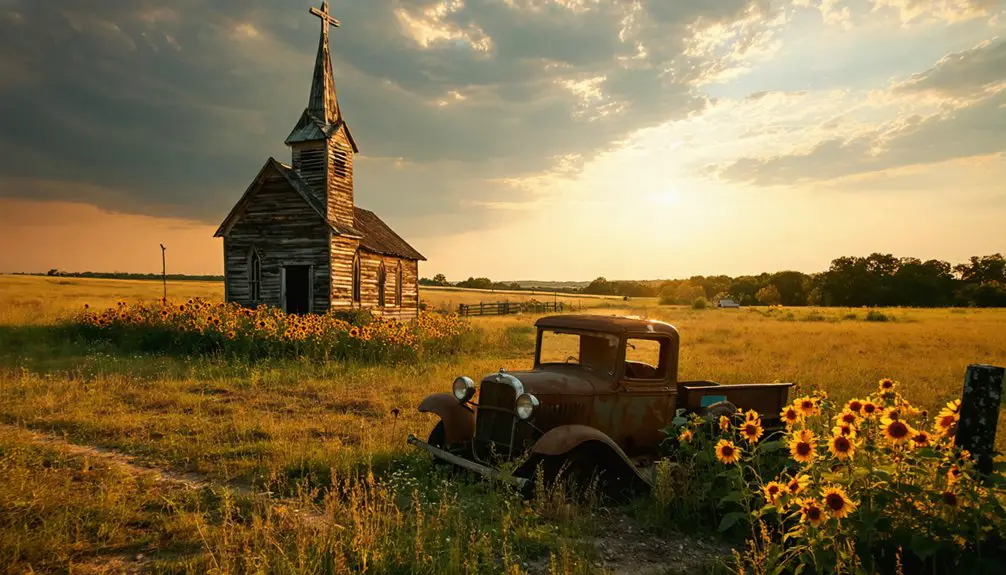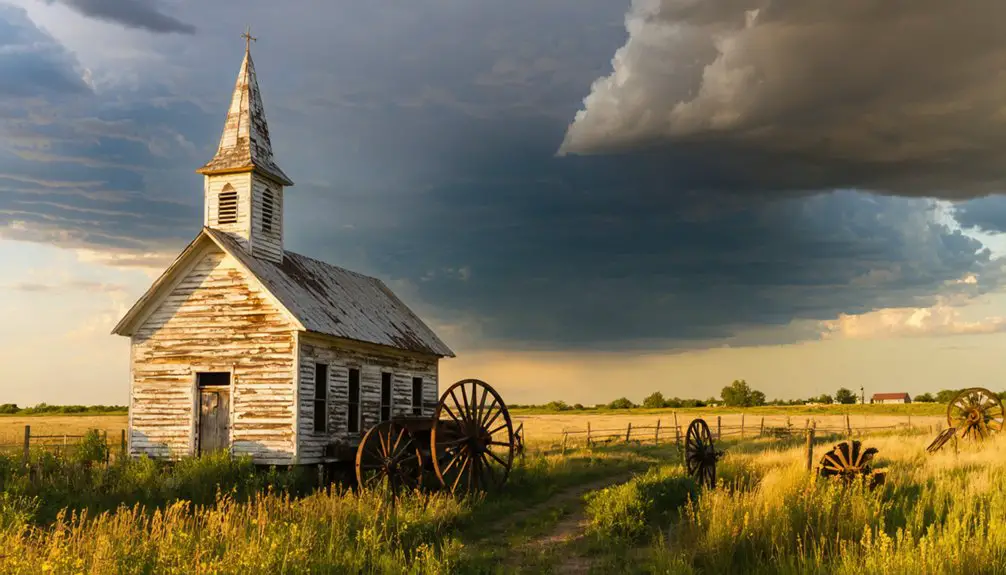You’ll find the ghost town of Saratoga in south-central Kansas, where it once thrived as a bustling prairie settlement in the late 1800s. The town flourished with schools, stores, and a strong farming community until transportation routes changed and agricultural markets collapsed. Today, nature has reclaimed most structures, leaving only weathered ruins and railroad remnants as silent witnesses. Its empty streets hold fascinating tales of pioneers, economic struggles, and the dramatic cycles of Kansas settlement history.
Key Takeaways
- Saratoga, Kansas transformed from a thriving prairie settlement into a ghost town following economic decline caused by shifting transportation routes.
- Railroad connections initially fueled the town’s growth through cattle shipping, but their eventual loss contributed to its abandonment.
- The community once supported schools, churches, and social gatherings before agricultural modernization and market collapses led to its downfall.
- Physical remnants include dilapidated structures, railroad depression marks, and scattered debris overtaken by dense vegetation.
- The town’s history involves a notable rivalry with Pratt over county seat status during its decade of prominence.
The Rise and Fall of a Prairie Settlement
While the American prairie beckoned settlers with promises of prosperity in the late 1800s, Saratoga’s story exemplifies the dramatic rise and fall of countless Kansas settlements.
The untamed Kansas prairie held grand promises, yet settlements like Saratoga reveal the harsh realities behind those golden dreams.
You’ll find a tale of pioneer resilience in this once-thriving prairie community, where railroad connections sparked initial growth and commercial success. The town flourished as a bustling hub for cattle shipping and local trade, supporting schools and essential community institutions. Like many of the state’s over 6000 dead towns, Saratoga’s development followed familiar patterns of frontier expansion and eventual abandonment.
But you can trace Saratoga’s decline to shifting transportation patterns and agricultural modernization. As railroads realigned their routes and farming became increasingly mechanized, the town’s economic foundation crumbled. Like nearby ghost town Iowaville, which operated a post office from 1874 to 1902, Saratoga gradually faded into obscurity.
The younger generation sought opportunities elsewhere, leaving aging buildings and dwindling populations behind. Without economic diversification, this once-promising settlement couldn’t adapt to the changing times, transforming from a vibrant community into a ghost town.
Life in Early Saratoga
You’d find daily pioneer life in early Saratoga centered around essential activities like farming, blacksmithing, and operating the local sawmills.
At the heart of the community’s social fabric were the taverns and general stores, where settlers gathered to exchange news, trade goods, and find brief respite from their laborious routines. Settlers often congregated at Henry Kennedy’s tavern, which hosted the township’s first official town meeting in 1858. Similar to early settlers in other regions, the pioneers faced significant hardships in developing the wilderness areas.
The Irish heritage of many early settlers shaped the cultural traditions, while the constant need for vigilance against potential threats created a tight-knit community bound by mutual support and survival.
Daily Pioneer Activities
Life in early Saratoga revolved around the demanding rhythms of mining and agriculture, with most residents dedicating long hours to lead and zinc extraction in hazardous conditions. Like the westward expansion pioneers of Atchison in the 1850s, these early settlers faced immense challenges establishing their community.
Your daily routines would’ve been filled with pioneer chores that began at sunrise and didn’t end until well after sunset, testing your resilience and self-reliance at every turn. As the Summit Hill Cemetery suggests, the settlement was planned to be much larger than it ultimately became.
Essential daily activities included:
- Hauling water from wells or streams for drinking, cooking, and washing
- Tending to crops and livestock while maintaining vital food supplies
- Performing labor-intensive household tasks like hand-washing laundry and cooking on wood stoves
You’d find yourself walking or traveling by horse-drawn wagon to access basic services, while relying on community support for education, medical care, and maintaining public infrastructure.
The town’s survival depended on your ability to adapt and persevere through these challenging conditions.
Social Gatherings and Traditions
Despite the harsh realities of frontier existence, social gatherings formed the heartbeat of early Saratoga’s community spirit. You’d find locals congregating at the church for religious services, musical performances, and festive traditions that strengthened community bonds.
The schoolhouse bustled with plays, holiday celebrations, and community meetings that brought everyone together. When you weren’t attending lodge meetings or seasonal fairs, you might join your neighbors for rabbit hunts that often ended in communal dinners.
The post office and general store served as informal meeting spots where you’d catch up on local news. During holidays, especially Christmas and Fourth of July, you’d celebrate with picnics and fireworks. Like many Kansas communities experiencing population decline, residents maintained strong personal connections until the very end.
In mining boom periods, you could even find entertainment at dance halls and saloons that dotted the landscape. Much like in Empire City, these establishments attracted crowds seeking gambling halls and saloons for evening entertainment.
Economic Factors Behind the Abandonment
You’ll find that Saratoga’s downfall began when changing transportation routes bypassed the once-promising town, leaving it increasingly isolated from essential trade networks.
The town’s heavy reliance on farming proved catastrophic when agricultural markets collapsed, forcing many local farmers to abandon their fields and seek opportunities elsewhere. Like other Kansas settlements such as the Buttermilk Community, the town struggled to sustain itself without key infrastructure and services.
Without railroads to ship their goods and facing plummeting crop prices, Saratoga’s residents couldn’t sustain their community’s economy, leading to a swift exodus of its population. Similar to other struggling communities of the era, workers faced dire conditions earning only $1.25 per day.
Transportation Routes Changed
While Saratoga’s early success relied heavily on its railroad connections, changes in transportation routes ultimately sealed the town’s fate. You can trace the town’s decline through pivotal shifts in how people and goods moved across Kansas. The railroad impact was devastating when main lines bypassed Saratoga, cutting off essential commerce and passenger service that had once fueled its growth.
By the mid-20th century, the change from rail to truck freight left Saratoga stranded without adequate shipping options.
Highway bypasses diverted traffic and commerce to neighboring towns with better road access.
The loss of transportation connectivity discouraged new businesses from establishing roots, while existing ones struggled to survive.
The town’s isolation from modern transportation corridors led to its inevitable abandonment, leaving only wheat fields where a bustling community once stood.
Farm Market Collapse
As Kansas farmers ramped up wheat production in the mid-20th century, they inadvertently sowed the seeds of Saratoga’s economic destruction. The surge in commodity grain output flooded the market, causing prices to plummet below operational costs.
You’d have seen grain elevators bursting at the seams with unsold wheat sitting under tarps, a stark symbol of the market’s collapse.
The vicious cycle of falling farm income forced many of Saratoga’s farmers to sell their land and move away. Agricultural policies couldn’t prevent the wave of foreclosures and bankruptcies that followed.
As farms consolidated under absentee ownership, local businesses shuttered their doors. The town’s younger generation sought opportunities elsewhere, leaving behind aging farmers struggling to maintain their operations.
Saratoga’s transformation into a ghost town became inevitable as its agricultural foundation crumbled.
Remnants and Ruins Today
Though decades of abandonment have taken their toll, Saratoga’s remnants paint a haunting portrait of its former existence. You’ll find dilapidated structures, weathered wooden beams, and scattered building materials telling stories of the town’s past.
Time has erased much of Saratoga, but its crumbling bones whisper tales of bygone days through weathered wood and broken stone.
Nature has steadily reclaimed the land, with dense vegetation growing through foundations and around collapsed walls. The lack of preservation efforts means these ruins continue to fade into the Kansas landscape.
- Railroad remnants reveal themselves through subtle ground depressions and occasional metal fragments.
- Seasonal changes affect your ability to spot artifacts, with dense summer foliage often concealing historical treasures.
- Scattered debris like broken glass, ceramic pieces, and rusted farm equipment offer glimpses into daily life.
The site remains largely unmanaged, leaving you free to explore the raw, untamed ruins at your own risk.
Local Stories and Legends

Unlike other Kansas ghost towns rich with paranormal tales, Saratoga’s legends focus primarily on its bitter rivalry with Pratt during a decade-long county seat dispute.
While nearby towns like Stull boast dramatic ghost sightings and supernatural encounters, you won’t find stories of haunted buildings or vengeful spirits in Saratoga’s local folklore.
Instead, the town’s oral traditions paint a more grounded picture of decline and abandonment.
You’ll hear tales of community despair following Saratoga’s loss of prominence, but these stories lack the paranormal elements common to other Kansas ghost towns.
Where places like Stull Cemetery teem with accounts of white ladies and demonic figures, Saratoga’s narrative remains rooted in its historical defeat – a reflection of how some ghost towns earn their name through abandonment rather than supernatural activity.
Historical Legacy in Kansas Settlement
The legacy of Saratoga extends far beyond its local legends and tales of rivalry.
You’ll find in this ghost town a microcosm of Kansas’ settlement story, where immigrant influence shaped the cultural fabric of mining communities. Saratoga’s rise and fall mirrors countless other resource-based towns that dotted the Kansas landscape during westward expansion.
The town’s mining heritage left an indelible mark on Kansas history through:
- Diverse workforce integration, bringing together European immigrants and African American laborers
- Economic contributions that fueled railroad expansion and industrial growth
- Social innovations in community building, as miners from different backgrounds forged new cultural bonds
Today, Saratoga’s empty streets remind you how boom-and-bust cycles shaped Kansas’ evolution from frontier territory to settled state, preserving lessons about economic vulnerability and community resilience.
Frequently Asked Questions
Are There Any Surviving Photographs of Saratoga’s Original Buildings?
While you’d expect historical documentation from such a notable town, there aren’t any known surviving photographs of Saratoga’s original buildings. The lack of architectural preservation means visual records haven’t surfaced in archives.
What Natural Disasters, if Any, Contributed to Saratoga’s Decline?
While you won’t find direct records of tornado impacts or flood damage in Saratoga itself, nearby towns suffered from these disasters, suggesting regional natural hazards may have indirectly contributed to its decline.
Did Any Famous Historical Figures Ever Visit or Stay in Saratoga?
You won’t find historical visits by famous figures in the records – no notable residents or celebrities ever made documented stops here. It’s a settlement that remained locally focused throughout its existence.
Were There Any Native American Settlements Near Saratoga Before Its Founding?
You’ll find the Kansa tribe’s settlements were closest to this area, maintaining villages near Mission Creek and along nearby rivers. Their historical significance includes building sophisticated earthen lodges throughout the region.
What Happened to the Cemetery Records of Saratoga’s Original Residents?
Ever wonder what time can erase? You’ll find that cemetery preservation efforts weren’t documented, and historical documentation of Saratoga’s burial records has largely vanished, though local historical societies might hold scattered fragments.
References
- https://www.legendsofamerica.com/ks-hauntedatchison/
- https://www.youtube.com/watch?v=alC1wDdSVvg
- https://www.youtube.com/watch?v=MyhOcQeCOVE
- https://legendsofkansas.com/everyplace-in-kansas-s/
- https://thewanderingpigeon.com/2015/10/03/day-of-kansas-ghost-towns/
- https://www.youtube.com/watch?v=VPZtNoncnig
- https://freepages.rootsweb.com/~gtusa/history/usa/ks.htm
- https://en.wikipedia.org/wiki/Truman_Capote
- https://legendsofkansas.com/kansas-ghost-town-list/
- https://dev.saratogawisconsin.org/history/



